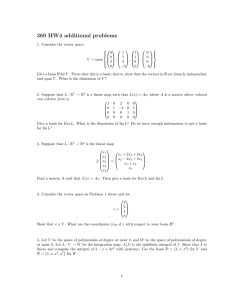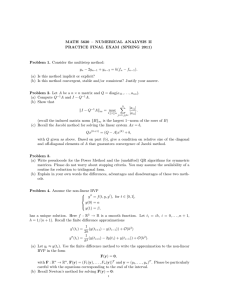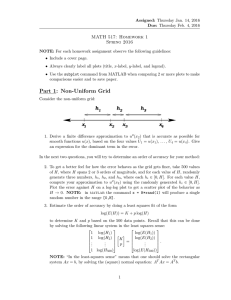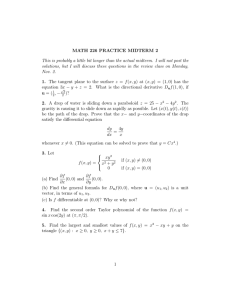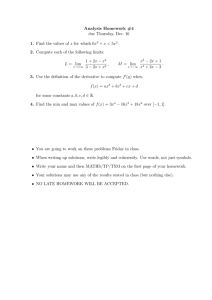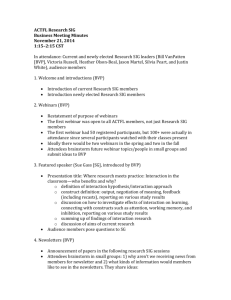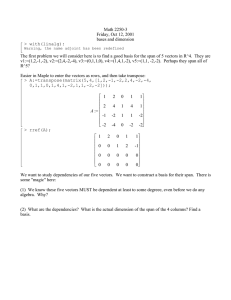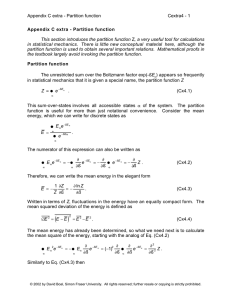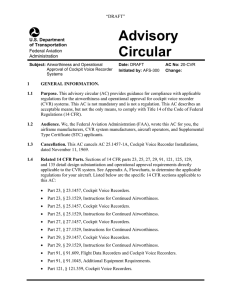369 Midterm 1 Your Name: Instructions:
advertisement
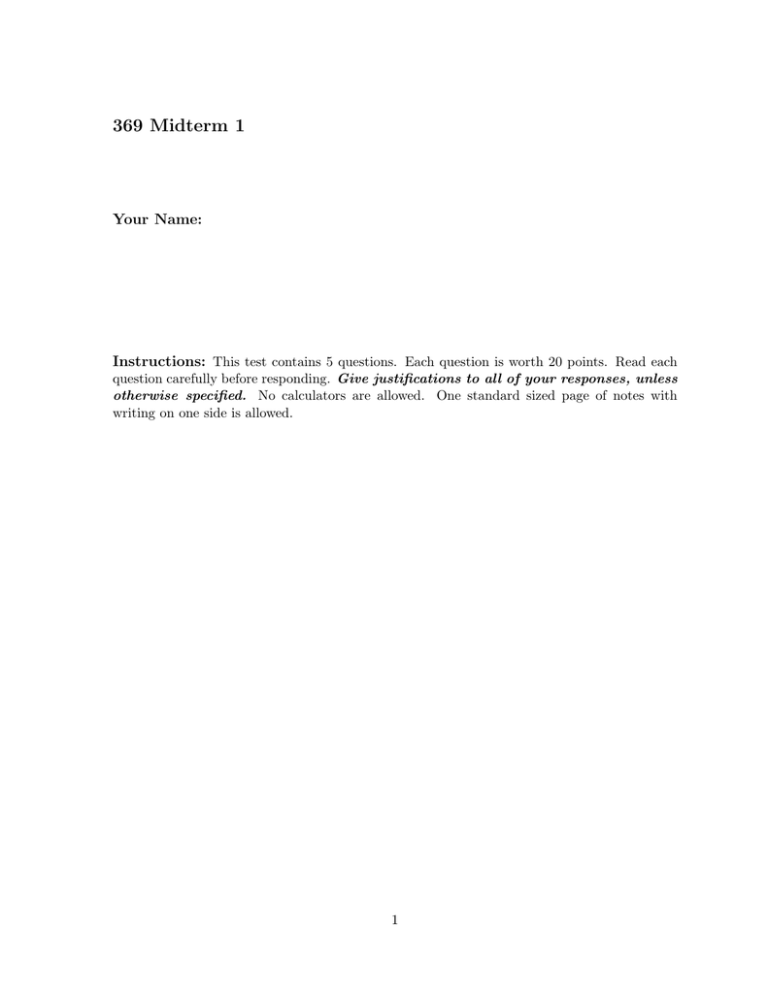
369 Midterm 1
Your Name:
Instructions: This test contains 5 questions. Each question is worth 20 points. Read each
question carefully before responding. Give justifications to all of your responses, unless
otherwise specified. No calculators are allowed. One standard sized page of notes with
writing on one side is allowed.
1
1. Let
1 −1 1 2
A = 2 −2 0 5 ,
−4 4 −4 0
1
b = 0 .
1
What is the solution set to Ax = b?
Solution. The RREF of the augmented matrix (A|b) is
1 −1 0 0 −25/16
0 0 1 0 21/16 .
5/8
0 0 0 1
Therefore, the solution set is all vectors of the form
1
−25/16
1
0
21/16 + x2 0 ,
0
5/8
2
x2 ∈ R.
2. Let A be a matrix whose reduced row
1
0
0
echelon form is
2 0 −1 0
0 1 4 0 .
0 0 0 1
(i) What is the rank of A? (No justification required.)
Solution. The rank of A is 3.
(ii) What is the dimension of the kernel of A? Do we have enough information to give a basis
for Ker A? If so, give a basis for Ker A.
Solution. A basis β for Ker A can be read off from the RREF of A:
−2
1
1 0
, −4 .
0
β=
1
0
0
0
In particular, dim Ker A = 2.
(iii) What is the dimension of the image of A? Do we have enough information to give a basis
for Im A? If so, give a basis for Im A.
Solution. The dimension of the image of A is (always) the same as the rank of A, which is 3.
In general, a basis for Im A cannot be read off from the RREF of A. However, since the image
of A is a 3-dimensional subspace of R3 , we can conclude that Im A = R3 and {e1 , e2 , e3 } is a
basis.
3
3. Let
1
−2
0
1 , 0 , −2 ,
β=
0
1
−2
2
v = 1 .
1
(i) Is the set β linearly independent?
Solution. No:
0
1
−2
2 1 + 2 0 + −2 = 0.
0
1
−2
(ii) Is the vector v in the span of β?
Solution. No. By (i), the span of β is the same as the span of the first two vectors in β. If
0
1
2
c1 1 + c2 0 = 1
0
1
1
then c2 = 2 and c2 = 1, which is impossible.
(iii) Is the set β a basis for R3 ?
Solution. No: the vectors in β are not linearly independent (nor do they span R3 ).
4
4. Let
0
0
1
0 , 1 , 0 ,
β=
0
1
1
1 0 0
A = 0 1 0 ,
0 1 1
2
v = 3
2
(i) Compute [v]β , the coordinates of v with respect to β.
Solution. Note that
2
1
0
0
3 = 2 0 + 3 1 − 0 .
2
0
1
1
Thus,
2
[v]β = 3 .
−1
(ii) Find a matrix B 6= A and a pair of bases D, R for R3 so that A = [B]RD .
Solution. Note that A is the change of basis matrix
A = [I]std β .
5
5. Let V be the set of polynomials of the form
a + bx2 + cx4 ,
a, b, c ∈ R.
Let L : V → V be defined by
L(a + bx2 + cx4 ) = 2b + 12cx2 .
(i) Prove that V is closed under addition and scalar multiplication.
Solution. This follows from basic properties of addition and multiplication:
(a + bx2 + cx4 ) + (r + sx2 + tx4 ) = (a + r) + (b + s)x2 + (c + t)x4
and
r(a + bx2 + cx4 ) = (ra) + (rb)x2 + (rc)x4 ,
where here a, b, c, r, s, t are all real numbers.
(ii) Prove that L is linear.
Solution. Notice that L(f ) = f 00 for polynomials f ∈ V . So from standard facts in calculus,
L(f + g) = (f + g)00 = f 00 + g 00 = L(f ) + L(g), and L(cf ) = (cf )00 = cf 00 = cL(f ).
Alternate solution. You could also check linearity directly:
L((a + bx2 + cx4 ) + (r + sx2 + tx4 )) = L((a + r) + (b + s)x2 + (c + t)x4 )
= 2(b + s) + 12(c + t)x2
= (2b + 12cx2 ) + (2s + 12tx2 )
= L(a + bx2 + cx4 ) + L(r + sx2 + tx4 )
and
L(r(a+bx2 +cx4 )) = L((ra)+(rb)x2 +(rc)x4 ) = 2(rb)+12(rc)x2 = r(2b+12cx2 ) = rL(a+bx2 +cx4 ).
Again, here a, b, c, r, s, t are all real numbers.
6
